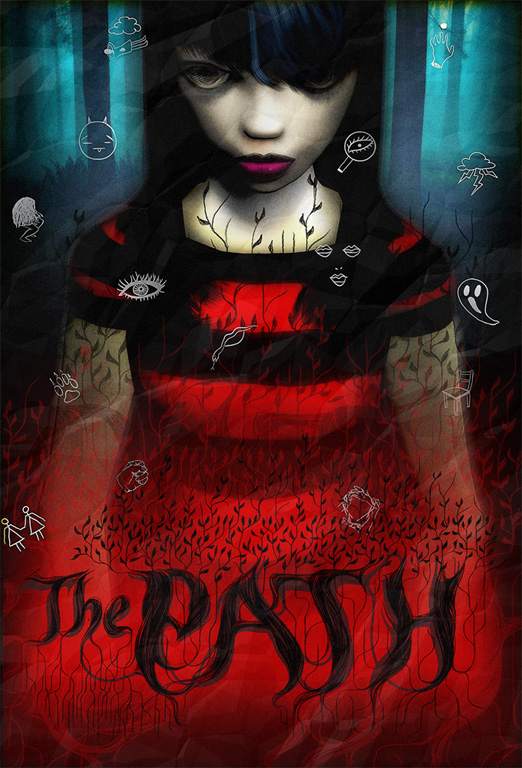
This is the story of how The Path came to be.
Through the dark forest: History of the project
Girls at play: Designing for exploration
In the belly of the beast: What went wrong and what went right
What’s in the basket?: Press, fans & sales
There is no woodsman to save the women: Conclusion
Through the dark forest
History of the project
Preparation
The idea for The Path is almost as old as Tale of Tales itself. In a June 2002 business plan, we presented our first project – 8, a dreamy adventure game based on Sleeping Beauty – as part of a series of games, each based on a classic fairy tale and with a number as its title. In another description of the 8 project, from October 2004, we express that we have plans for a survival-horror game based on Little Red Ridinghood. This game would be called 144.
In 2005, we started looking around for a production budget for 144. Some early requests with local Belgian arts funding bodies were rejected. But at the end of the year, the USA-based arts organization Creative Capital came through with an initial grant of 10,000 US Dollars. We were still working on the Drama Princess project at the time, but started directing it away from its original goal of driving the autonomous behaviour of the main character in 8, towards the more general character behaviour manager required by the new project. Not that The Path was a very clear idea at that time. But motivated by the support of Creative Capital, the design gradually became more concrete.
Prototyping
In July 2006, a first prototype was committed to our 144 repository.

The Deaf Mute Girl in the Pretty White Dress from the 8 project grew up a bit and became the Girl in White in 144
We decided not only to re-use the Girl in White character from 8 and the Drama Princess engine for autonomous characters, but also the environment rendering system of “The Endless Forest”. This re-use was one of our ways to reduce the development budget. After not being able to secure the, for us, gargantuan sum of 1.5 million required for 8, we were determined to make a game for a budget that was so small that we didn’t need the support of the games industry. For this reason, The Path was going to be a short game that was mostly non-linear (no plot-based narrative, emergent behavior, few cut scenes). And we were going to focus on digital distribution exclusively, not only because it makes sense in terms of technology, but also because it reduces production and marketing costs while drastically increasing the revenue share of the developer (meaning a much smaller volume of sales is required to break even).
At the very start of the project, we weren’t really sure if The Path was going to be a commercial title or a more artistic experiment. As we continued to refine the design, we realized that the concept had several things that spoke in favor of commercial exploitation. It was going to be a horror game, thus easy to categorize by the market (unlike 8 for which the main problem with publishers was that its genre was undefinable.) In The Path, we knew we were going to have stylish, dark, girl characters at a time where gothic Lolita style, and Pop Surrealism was very trendy. Cult rock star Jarboe had agreed to do the sound track. But most of all, we felt a sort of obligation, to at least try and make this step towards a market, instead of safely playing in the margins. Up until the day of launch, we had no idea how well this was going to work. But we decided to take the risk.
By the end of 2006, we had secured another 26,000 Euros from the Flemish Audiovisual Fund and Design Flanders for a first phase of the production. The support of Creative Capital continued throughout the project until the day of launch (which they funded). Ultimately, they have contributed almost 50,000 US Dollars to the budget (sadly at a time when the Dollar was at an all time low).
Production
In January 2007, we implemented the Drama Princess engine in the 144 prototype, which signified to us the start of the actual pre-production.
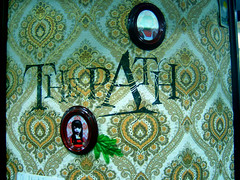
Images from our booth. Our first ever trip to the GDC.
The first teaser video for The Path.
In May 2007, a first prototype of The Path was sent to our collaborators, animator Laura Raines Smith, and musicians Jarboe and Kris Force, after which they joined the project in earnest. With their help, we created one of the six chapters of the game, featuring Ruby as its main character. This demo was entered in the Independent Games Festival in October 2007. In November 2007, we showed this demo to Valve and to Sony in Liverpool. But neither was ready to sign us up for their platform (Steam and Playstation Network) at the time. They seemed a little bit worried about where we were going to take the rest of the project, afraid that it might turn out to be too much art and too little entertainment (which was considered a liability back then).
That same month, November 2007, things got really serious when we signed a contract with CultuurInvest for a 90,000 Euro loan. As of then, working on a commercial project turned from being an exciting experiment into dealing with a scary Sword of Damocles that would play a part in each and every decision we were going to make. We realized all too well that paying back 100,000 Euros (the loan plus interest) is a serious commitment for even the most commercial independent company, let alone an artistically-motivated two-person collective.

Michael in our booth at Game Connection, Lyon 2007
December 2007 was an ecouraging month. We had decided to invest in the 3,000 Euro participation fee in the Game Connection in Lyon. Game Connection is an event where developers can present their projects to publishers through very short back to back meetings over the course of three days. Thanks to the loan, we didn’t really need publisher investment. But we wanted to see how commercially minded people would respond to our idea. Because we still weren’t sure if we were completely crazy or not. The response was remarkably positive. So much so that we even followed up on a few of the contacts made. But as usual all of it fell in the water sooner or later. Publishers seem so disorganized and unreliable sometimes.
In that same December 2007, Edge magazine featured a double spread about Tale of Tales that focused on our new production. And our demo of The Path was selected for “Excellence in Visual Art” in the Independent Games Festival. We personally had no doubt about the quality of our project. But we also had no illusions about the bias of the IGF jury towards more “game-like” videogames. They had rejected The Endless Forest the year before, so we weren’t expecting much better for The Path. And we still think that our game was not just selected on its own merit, but partially because of our big mouth. We had triggered a lot of discussions with several blog posts that were very critical of the current state of game design, without which it would have been a lot easier to ignore us. In short: the marketing plan was working!
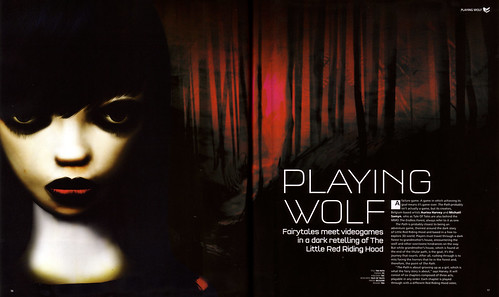
The 4 page article in Edge Magazine, December 2007 was very exciting and encouraging!
So, in February 2008, we were presenting The Path in the Game Developers Conference again. This time with a proper playable demo in the Independent Games Festival pavilion, among dozens of indie colleagues in the year when indie games really made their big push towards public recognition. It was quite an exhilarating experience. An intense three-day long playtest session from which we gathered heaps of information.
This gameplay video was made from the GDC 2008 demo.
Partially to force ourselves to take a break, and partially because of marketing benefits, we decided to interrupt the production of The Path briefly to develop a small game that we had acquired some arts funding for. In March 2008, we released The Graveyard. Since we had applied some of the ideas in The Path about minimalist interaction design to it, The Graveyard became an interesting test to find out how the audience would respond to our ideas. It was also a way to figure out the whole e-commerce thing. The Graveyard was not designed as a commercial title but selling a “full version” of the game with only one difference (the possibility of the death of the protagonist) was part of the artistic concept. And it makes no difference to Paypal what your intentions behind charging are. This experience helped us prepare for the commercial launch of The Path a year later.
Launch
On 17 March, the day before leaving for the Game Developers Conference, we “pre-launched” The Path with coproducer Villanella in the Muhka Media Film Museum in Antwerp. The evening consisted of an interview with Flemish culture diva Chantal Pattyn, a short playthrough of the game on a big screen, the opportunity for the audience to play the Path before its official launch date in the company of a Robin cosplayer, our first!
On 24 March, we had our public launch event in the Yerba Buena Center for the Arts, right around the corner of the Moscone Center where the Game Developers Conference was taking place. It was an intimate gathering, about 80 invited guests, with wine and bread and a play session projected on the big screen, accompanied by live music performed on the stage of the small cinema by Jarboe and Kris Force.
Girls at play
Designing for exploration
Uncertain design in the beginning.
The Path was an idea born with the title 144. It could have turned out very differently. The name 144 encompassed the spirit of the project. Somehow that number came to symbolize a girl’s restlessness, the sound of footsteps on dry leaves, the smell of pine trees, dim sunlight through filtering clouds. There were thoughts of graphite scribblings and white gouache on paper, of tricky betrayals of lovers, and of parents and children. Fearless naivete, anxiousness to meet your adulthood head-on, in the face and body of a wolf. He-wolf She-wolf.
The conception of the 144 idea was heady, painful and soul searching, in both Art Direction and Interaction Design, as we tried to discover the core of “what it all meant” in order to communicate even a fraction of these sensations, emotions and inner stories to the player of a computer game.
In the beginning there were in fact moments when we thought it would be best not to make the project at all.

‘Waldeinsamkeit’ is a German word which means the feeling of being alone in the woods.
We once had the notion that there would be 144 Red Ridinghoods and the player would play each one. Each time the story lead to her death. We came down from that illusion and narrowed the cast down to 6 girls, each representing a different aspect of a girl’s life. The number six was decided upon somewhat arbitrarily by dividing the number 144 and considering the aesthetics the number 6 provided and how 6 girls could fit into a chronology of growing up from age 9 to age 19.
We decided each girl needed her wolf, an alter-ego. And that she should meet this nemesis in a specific place in the Forest. We called these locations “Attractions.” There were also to be “Distractions” which are the objects one encounters, that keep you dallying in the Forest instead of continuing on to Grandmother’s like a good girl. We thought perhaps each girl should meet each wolf and the player could mix Girl/Wolf/Attraction and match the experience and place. This also seemed like too much to do technically for us. Too many possibilities to plan for. So, early on the idea was simplified to each girl having a set scenario. A representative area to meet her wolf in and a division of objects and environments some shared and some unique.
Character Design and Environment Design: Artistic impression vs accessible game : a personal meaning
Design of the girls. We kept a fairly detailed diary of the Making Of each girl. We didn’t give them names until the game was almost done. All along we’d referred to them by the archetype they represented for us.

The girls got names: Kid Red (Robin), Innocent Red (Rose), Tomboy Red (Ginger), Goth Red (Ruby), Sexy Red (Carmen) and Stern Red (Scarlet).
While the wolves and other characters remain nameless.
When designing The Red Girls, in addition to too many outside references to name, I (Auriea) did a lot of looking inward. I was not meant to be the sole designer or modeler of all protagonists. I didn’t want to do it out of a lack of self-confidence and also I was worried that I’d put a bit too much of myself into them. In the end that is what happened. And in some ways I think this is what leads to many misunderstandings of the narrative of the game. Some say blindly that the game is “about rape.” And while that could be one of the interpretations -and I understand it-, for me, those black-out moments after meeting her wolf are the moments of realization. Those are the times when a girl grows. And what happens in Grandmother’s House is not a murder but a shedding of childhood and an initiation to womanhood. Each girl one step closer to her fate. Due to our method of control you do not really control the girl at all. There is a moment where you realize that all outcomes are the result of her choices. And she could have prevented it by not acting for that one moment, by not seeking the “good time” of her nemesis. By staying on the path.
We force the player into that compromising situation much like a film director does. You don’t have much choice in the matter. Every time it is a choice of letting her go, or doing nothing, or wandering endlessly in the forest, or shutting down the game entirely. If you play on we hope that you will draw your own conclusions. Maybe there are things in there that relate to your own life. For many girls and women there were, in fact, and they have told us so. It is beyond amazing to learn of the many ways these scenes impacted and reflected what people felt about their lives and the choices they have made. The game becomes a tool for this reflection. And I think if at first I had not also gone through that process, of letting each girl come out of me, no one would have felt anything at all. It is a question of the characters feeling real in an ethereal way. They are mere expressions of what you are already thinking. So, whatever your interpretation, it says more about you than about whatever the situation has meant to me. In that vagary of the blackout lies infinite possibility.
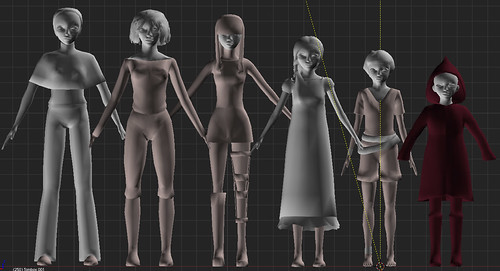
We’ve never really spoken much about the Wolves. Inspirations for Wolf characters… I couldn’t even explain it. Every girl has her wolf, no? I tried categorizing every boyfriend I ever had into one of these archetypes. Not that I believed “all men” are one way but more, the way I had experienced them, and the relationship I’d had, or that I’d wished had been. Woodsmen Wolves were silent and no matter what, always chopping endlessly at the same tree. They need to be provoked to get any reaction from them at all. Cloud Wolves are silent beautiful spirits. And though they seem skinless and vulnerable, perhaps it is just a lure into a thunderstorm. We wanted our Werewolf to be at once comical and scary. “Cuddly” for lack of a better word. And you have to want to walk up to him and climb on his back for a ride. The inclusion of one female wolf, one which the Tomboy, Ginger meets is more a reflection of her femininity. The Girl in Red Wolf disappears as you try to approach her. Bursting into a hundred butterflies. Only when you turn your back and let her come to you do you get a chance to meet her face to face. In all cases we did not want to make typical male game characters that looked like they would overpower the girls. No, the wolves need to be ordinary thus to raise a question in the player’s mind about who is exactly in control of the encounters in the forest. We made up stories about each one of these characters, how and why they need each other and what that meeting does to the endgame.
Very early on we worked with concept artists. I was anxious to prove that it would be possible to bring in some amazing artists who could take our vague ideas and surprise us with a new interpretation. We got 3 great people working on The Forest, the Red characters and Grandmother’s House to prepare for making our first real demo of the game. The demo would contain Ruby, her wolf, “Charming”, and the Girl In White. There were things we knew about them. I tried to distill this into reference sheets and vivid descriptions. And we loved the character drawings coming from Ted Pendergraft. But he was super busy at the time and we really couldn’t afford him. He left the project, continuing on for awhile as a consultant to us, it was nice that he gave us a bit of his time. Stacey Diana Clark seemed to get what we were going for right away and we ended up using her gorgeous artwork of the forest all the way through the design process. The only pity was that we couldn’t afford to have her make more! We had long conversations with Pedro Murteira and he had exactly to right kind of imagination for our rambling ideas of Grandmother’s House. We put him though such phrases as “it is a memory of a house. A girl child enters the place of a woman whose life is done, what does she really know about her?” Grandmother’s House is based, at least in part, on a recurring nightmare I had about my Grandmother’s old house in the 80s. We needed a way to express in “reality” all these dreams. In many ways these talks and quick sketches very early on totally helped us organize our thoughts as for the first time we had to express into words what we were hoping other people could understand.
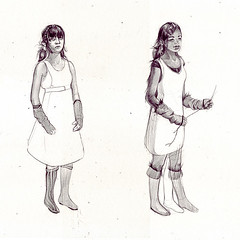

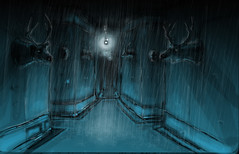
The work of Ted Pendergraft, Stacey Diana Clark and Pedro Muteira was great, and our time with them too short.
It was a big question who would actually do the modeling of the characters and environments. For the first demo we had help from Dragon-Fly for objects. The rest were modified from objects we downloaded from Turbosquid or made from scratch. Back then I didn’t have a whole lot of confidence in my modeling skills. I had no problem with the Forest parts because I have become a tree modeling, forest making expert due to The Endless Forest work. But I thought, surely, we would contract out the building of Grandmother’s house, at least. We ended up searching for people and wasting a lot of money in the process. We had tested several modelers to work with us and had high hopes of finding someone that we could work with permanently. But it didn’t work out. The problem was that we knew far too well what we wanted by that time. Model design style: dolls but not cartoons, a kind of creepy cute look. But we felt that a 3D style is something where you have to trust the individual modeler to give. We wanted to find something outside of our preconceived ideas about these characters. We didn’t have detailed character concept drawings and must have been a nightmare to make a test for. We learned how to work with other people and how not to work with them. Our experience re-enforced the feeling that we should not, under any circumstances, be managers of other people. This is why we work the way we do now. In Fatale, the project we made immediately after The Path, we put it to the test by working in a purely collaborative method with modeler Takayoshi Sato. We work in this loose way with musicians all the time. And when Laura Raines Smith animates we have a relationship of artistic trust. We know she understands what we want and we don’t have to edit her. This is the relationship we want to have with all our collaborators from now on. Everyone invested in the work, everyone with their specific part and in the end we maintain the vision but mix all of these parts into the whole.
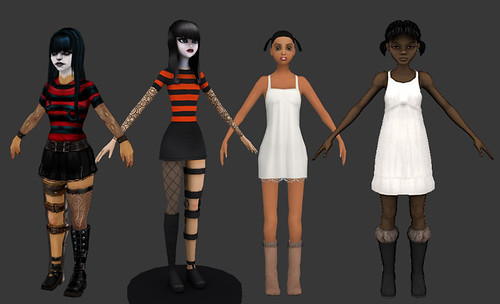
Test models by Ben Regimbal, Vykarian, Billy Miller and Greg Savoia. Guys, we’re sorry we didn’t know what we were asking of you.
After the GDC 2008 demo, due to time and money and a deep connection to the game’s themes and riding the wave of adrenaline after presenting the demo for days at the Independent Games Festival and this incredible feeling of “LETS JUST GET THIS THING DONE!” I decided the only way was to make everything myself. In the end I am overjoyed that I took the job and literally forced myself to grow up to the tremendous challenge of making all 14 character models, and the 3 environments. But it was a difficult development period and it was literally insane of me to do this all by myself in the short development time we had.
And so, there is not a lot of beautiful concept art from the project. It is not that I didn’t want it, but I must admit I doubted it’s practical usefulness anyway in bringing out what I wanted this fully 3D world to be. 2D is not 3D. I needed to feel this world with my hands. Michaël had programmed up all these cool tools for us to use in Quest3D like a viewer with all the characters standing in a line and it let us cycle through all their animations. And a sort of dollhouse view of Grandmothers House to see all the possible configurations, add and remove objects, and follow each girl’s path through the house. I don’t know if we will use Quest3D again for a project but it was truly beautiful at times to be able to make changes, paint flora in the forest, walk with the girl in realtime without having to stop and compile. What I saw was what I got. “Concept art” for me became things like the glitches which would sometimes spring up in Quest3D’s realtime window.
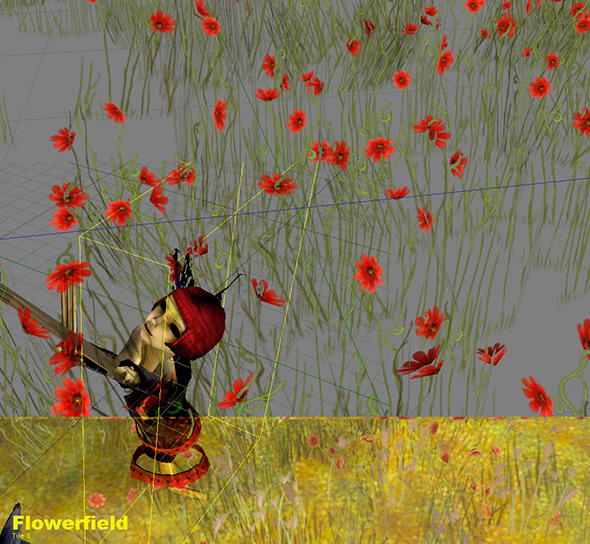
We kept an archive of beautiful glitches.
Or serendipitous interactions between bad programming and the sound in my headphones.
Glitch-filled journeys through Grandmothers House while working listening to music in my headphones (above), influenced the design of the teaser videos released (below) once the musical score was finalized.
That was the experience I wanted the players to ultimately have, moments where my heart was moved but I don’t quite know why. Moments of pure beauty and pure joy and pure pain.
Looking for an aesthetic style
It was our desire all along to experiment with the forest, to stylize trees, foliage and flowers. We followed our motto that it is more important that the place feel real than look real. I chose abstract baroque ornaments and patterns for things like leaves and flowers. The trees give the impression of having realistic looking leaves as you run past them. Everything is rendered in black without detail. This not only kept the amount of work to be done on them to a minimum, it also gave the world a somber surreal feeling. Bits of color come out only in the Attraction areas where the world bursts into full over-saturation. We looked at artifacts from failed photographic processes; light leaks, bokeh, Polaroid film glitches. We soften and blur the image and give it a patina, making the screen dirty, then finding a use for the dirt. We came to the “double exposure” effect of overlaying the center of interest as a clue. All the little scratches or paw prints on the screen lead you to your wolf, the white swirl leads to the Girl In White. It was important that all of these effects have a purpose and there is nothing on the screen that doesn’t in some way serve as a clue for the player.
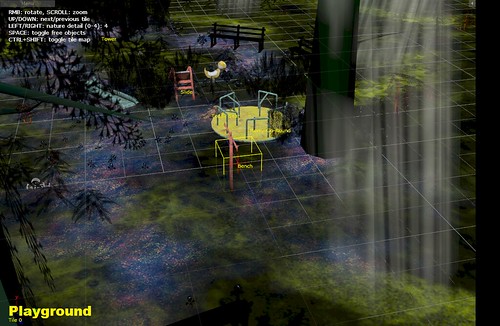
The Quest3D Nature Paint system made it very easy to quickly paint in the trees. We had help from Paladin Studios to help us refine the ground shaders and optimize the post processing shaders.
When it came to overall color, I knew that I wanted a way for the color itself to be horrific. Not a typical film-like graininess or blue-for-night effect but really strike people with the color, like a Dario Argento horror film. I feel it sets our horror game apart from the rest. The color and stylization of the forest contrast with the more somber versions of Grandmother’s House and make the Wolf violated versions all the more striking.
We did not want to compete on 3D graphics with big 3D game titles. We wanted it to be unique, as if every screen were somehow handmade.

When we changed the name of the game from 144 to The Path we designed a logo. We got tired of constantly searching for an answer whenever someone asked “What does 144 mean?” Also we wanted a name easier to remember. After a while we got the feeling that the logo we’d made was way too much like a movie logo, or too typical ‘grunge’ of a type treatment. We commissioned typographer & graphic artist Marian Bantjes to make us a logo which felt more in-keeping with the spirit of the girls and the forest. And the rest is history.
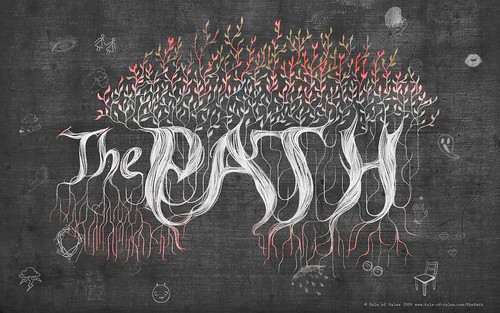
Prototypes and Demos and Music
Our process consists of making the game and then designing it. Using prototypes as a tool for guiding the design. As soon as we can we want to have something in the game engine to play with. It really cannot exist for us in theory, only once we have “made it real” in prototype can the idea mean anything. We do not want to be mislead by a pretty drawing or model. We want to get a camera in place, work out some preliminary navigation. We are then constantly looking at that prototype or videos of it. And from these we iteratively make the decisions which become the final game.
Through this process we came up with ideas and quickly implemented them in the game with he actual characters. So we would get an idea if things are a good idea or not. Since the engine had originally shared code from The Endless Forest we thought we might make the player into a kind of puppeteer. We had interfaces of buttons connected to animations which needed to play out in a certain sequence to act out a scene. In one early prototype we had made a version where you could switch between characters and play the Red girl, The Girl in White or The Wolf at any time. It was inspiring, like a play where actors can jump from one body to the next! But we felt it would add too much work to make it this way unless we were to have only 3 characters in the game. In another version we had a dance choreographed between Ruby and Charming Wolf!
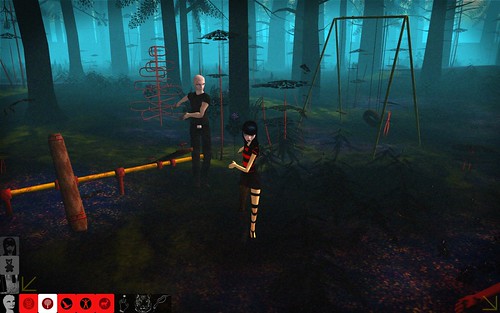
Rejected gameplay idea: The dance-off! yeah!
Once we got a few of the final music tracks we could tell that this was not going to be in any way a lightweight game. The music Jarboe & Kris Force made for the game had such an enormous effect that it changed our thinking about the game design. And this, we feel, is as it should be. A videogame should not be seen as its individual parts. Each individual model is not a sculpture onto itself but more like a brush stroke in a larger picture. The entire game is the ‘sculpture’. I just put emphasis (more detail) on the parts where player’s interest should be held the most. And this philosophy is quite helpful to the Indie Developer making a 3D game. One need not waste time and assets trying to make each individual thing perfect and “realistic”, make it beautiful instead in its totality. Let imperfection shine by putting together assets made with the whole heart and the intention of making a complete world.
In the belly of the beast
The Path was our first commercial videogame project. And also the biggest project we’ve worked on so far. It was a completely independent production: managed by ourselves and funded with art grants and a loan. It was both an experiment with the “punk economy” advocated by our Manifesto and a conscious effort to make our art more accessible to gamers and less savvy computers users alike, while optimizing its appeal to a non-gaming audience.
What went wrong
Not enough time
This probably happens in every videogame production: many great ideas need to be abandoned because of lack of time. In the production of The Path, we also had to make some tough choices between improving our technology and polishing art. Since we thought the aesthetic appeal of The Path was going to be one of its strongest features and since we are far from master programmers, we compromised heavily on the technology side. It didn’t matter too much to us that characters would walk through trees once in a while or that their AI didn’t always kick in at the right times. We even enjoyed the chaos this produced. As long as the game felt right. But some players were turned off by the lack of technical excellence. It’s surprising how many gamers are only vaguely aware of the enormous cost of game development and the precarious situation of independent developers. While in our experience, things like bad performance on some hardware is directly related to budget limitations.
Recruiting a modeler
We didn’t originally intend for Auriea to design, model and texture all the characters. This is a time consuming task, and her tasks as Data Director were far more crucial to the project. But all the modelers we tested just couldn’t get the style right. To create stylized characters for a horror game that are not cartoony but still attractive, is apparently a skill not taught in 3D academies. Part of the reason probably was that we only got male candidates. Our experience with finding our wonderful animator Laura Raines Smith had taught us that it takes a woman to animate girls properly. Maybe it takes a woman to model girls as well. We don’t blame the men. We blame the fact that more women don’t choose 3D modeling as a career! And that we couldn’t find the right person when we needed her.
Bad crunch
We had planned the production to be finished quite a bit before launch to allow us sufficient time to fine-tune the experience. But as the work kept piling up and progress was slower than expected, we started eating into that time as if it were a mere buffer zone. To compensate for this loss, we worked harder. For four months in a row, we worked 14 hours per day. After a while you get used to it. It’s even easy to some extent because the extreme pressure forces you to only work on the most important parts of the production while you can safely ignore everything else. But it’s just not a good idea. It’s bad for your temper, bad for your health and worse of all, it’s ultimately bad for the project because there’s no time for reflection when making decisions.
Sadly, the only way to have prevented the crunch would have been to reduce the scope of the game. So in the end, we don’t really regret it, even if we are determined to stick better to the plan next time.
Publishers & Console Companies
We didn’t really need support from publishers for the development of The Path. But had we not designed the production to fit into a small budget, it is safe to say that The Path would have followed 8 to the Land of Unfinished Dreams. The climate in the games industry had certainly improved, thanks to the commercial viability of a greater variety of games. The success of casual games and Nintendo’s Wii and DS consoles had certainly stimulated the interest of publishers in games that might be smaller than blockbusters and perhaps even original in design. But in the end, it is still the bean counters that make the decisions. So while the interest was great, the support was ultimately non-existent.
The non-gamer audience
A more painful place for us to fail was our hope to reach an audience outside of the typical gamer demographic. We thought that designing a game with an original aesthetic appeal and theme and an interaction system that was very easy and forgiving would be enough. But without proper marketing, this just doesn’t work. It’s easy to market to gamers because they form a very well organized subculture with a blooming press and myriads of supportive blogs. But outside of the niche, the audience is fragmented, and in general fairly hostile towards videogames.
This is a serious problem for independent developers, and somewhat of a vicious circle for innovation in the industry. There’s a contradiction in the fact that it takes independent developers to create projects that may appeal outside of the core audience and that it takes a corporate budget to market to this audience. We’ve always found it strange that the small companies are the ones taking the risks, while surely the big ones are a lot more resistant to failure.Things being the way they are, growing the audience for videogames towards a greater diversion, will be a slow project, if it ever happens.
This puts us in a strange position. On the one hand, we really want to create titles that show non-gamers how enjoyable videogames can be. But on the other, ultimately, only gamers will buy our products. It is difficult to resist the urge to give in and make our games more game-like. But if we don’t explore the vast terrain outside of games, who will?
No post-launch budget
By launch time, we were virtually broke.
Independent marketing consists for the most part of manual labor: sending emails, posting to forums, talking to press, making blog posts, etcetera. But we couldn’t afford to do that full time. Let alone purchase advertisements or investigate even more expensive options like porting the game to a console or developing new downloadable content. We didn’t even have a budget for developing a representative demo.
If we hadn’t made such a bad deal with CultuurInvest concerning paying back the loan (we owed them 100% of our income until the loan was paid back), we could have reinvested some of the money coming in into increasing the reach of the game. We should not have accepted that part of the deal. It only took us half a year to pay back the loan but by that time a lot of opportunities had passed us by and sales had obviously declined.
Not commercially viable
We were never certain how much money we would make with The Path. Not in the slightest. We didn’t know if we were going to sell a few hundred copies or hundreds of thousands. We literally had no idea.
The total production budget of The Path was around 300,000 Euros. And so far, one year after launch, the Path has brought about 135,000 Euros back to us. A quarter of the budget was covered by previously developed technology. But even if we would subtract that, we would still be 90,000 Euros short of breaking even. It’s doubtful if The Path will make that much in the second year of the two year period we gave ourselves to sell the game. But of course one never knows.
On the positive side, however, we have been able to pay back the loan. And the rest of the budget was covered by non-commercial arts funding. So, in purely financial terms, we did break even. We were just hoping that The Path could be a test case for demonstrating the viability of artistic projects in a commercial environment. But so far it looks like the support of non-commercial funding is still required to do this type of work.
What went right
Did it
We succeeded in what we set out to do: to create a mid-sized videogame from start and finish and publish and distribute it to an audience. This may seem obvious. But each videogame that is created is a little miracle. Videogame production is a constant struggle with what the technology is capable of and what it will let you do. And developing with a small team on a limited budget does not make that easier. So whatever anyone may think, however we may feel about the outcome, we are proud simply of having made this thing. Because, as we often say, it’s better to make something than nothing.
Accessible technology
One of the main reasons why a small team without engineers is able to create a complex piece of software like The Path is the technology that is available now. We did all of the modeling and texturing in Blender and all of the programming in Quest3D. The latter deserves a special mention because it is quite a unique tool.
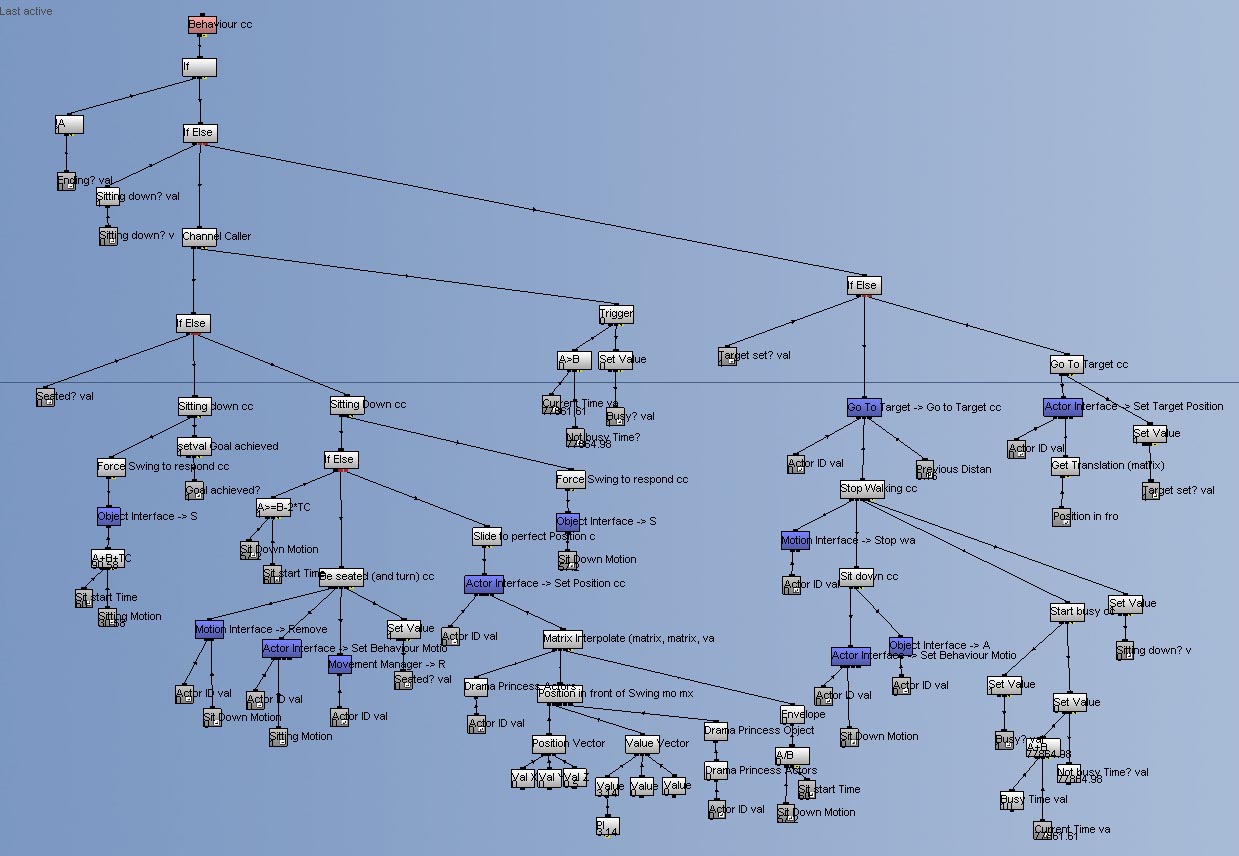
In Quest3D, you don’t write code. You express your ideas about processes and interactions through flow charts. Much like the flowcharts a programmer might draw to design a certain routine before coding it. Only in Quest3D, the flowchart actually works, with no additional coding. And it works in real time! As you connect the elements of your flowchart, the behavior of your application changes. The visible programming interface combined with the direct feedback make Quest3D a superb tool for artists to work with software.
The biggest downside to Quest3D is that it can only output applications for Windows. Luckily we found Transgaming willing to port The Path to Mac OSX through their Cider technology. This was not straightforward, but between the excellent engineers at Transgaming, the personal assistance of the Quest3D team and our own modification of the game, we succeeded in making a Mac version of The Path by May 2009.
Working with artists
Each member on the development team for The Path is an artist. Not just an “artist” in the games industry sense of the pairs of hands required to make Thee Mighty Code look and sound pretty to human players, but an Artist in the sense that they are capable of communicating on a profound level through their medium. We chose to work with certain people because of their artistic gift, not to fill any vacancies. Between Auriea and Michaël, there’s sufficient skill to make an entire game at Tale of Tales. But we knew that the contributions of Laura, Jarboe, Kris, Hans and Marian would make The Path immeasurably better.
Common knowledge has it that artists are difficult people to work with. They tend to have strong personalities and huge egos and are all but team players. We are artists. We know. But our collaboration with these people came out of a deep respect for their work. We did not just need people to do the stuff we had no time for. We really wanted their contribution in our game. Sometimes we felt like gallery owners setting up a show for them. We created a place for their work in ours and expected them to fill it with greatness. And this turned out to be an excellent way to get a group of headstrong individuals to create a thing of beauty together.
It probably didn’t hurt that most of us were female. But that’s another topic.
Testing
Before The Path, we had never done a lot of playtesting for any of our projects. Here and there, we had people try out early versions of our work. But this rarely had any real impact on the design of the game.
This time, we sent a message to our mailing list to invite people who live in or near Belgium and were available for an entire day to come and play The Path at our studio. Many people responded and in the end we made 12 appointments. Each tester would come to our studio and play the game in a room set up for the occasion. The first few hours we would sit there and watch them play without saying much. Then we would evaluate their experience over tea. After that, we would leave them alone for a few more hours, to play the game in private. This series of thorough playtests has really been eye-opening to us and probably greatly contributed to the accessibility of The Path. Many things were changed in response to these tests. Sometimes it was difficult to find a balance between fine-tuning the game for a specific audience and opening it op to a wider one. So we had to make some hard decisions about whom we were making the game for (in the end, the enthusiasm of the newbie player trumped the skepticism of the hardcore gamer).
We observed the testers playing the game. and wrote a short summary on the blog at the time about each session.
A second round of tests was done when the game was almost finished, mostly to find technical errors. This test was done through the internet. Testers would download the latest build of the game and play it for hours, days, weeks. Some people were very dedicated. They would report their problems via a web-based bug tracking system (Mantis) -using a bug tracker was also a first for us. We are -and all players of the game should be- very grateful for their devoted volunteering because it made The Path as stable and reliable as it is today.
Marketing
We had always been very active on the internet. In a way, the internet had been our home, our country, for a long time. When Web 2.0 happened, it felt like our land was being overrun by immigrants. And we retreated. Into videogames, actually. So when, a few years later, we figured out how to publish a commercial game independently, reconnecting with the internet felt like exploring a land that was still very familiar but where lots of things were done differently. But we felt more than comfortable with the idea of using the network for the promotion and distribution of our new work.
As of then, to some extent, everything we did online served as marketing for The Path. The Tale of Tales blog served as a central hub. It wasn’t like we didn’t have any controversial ideas, or interesting thoughts. We just didn’t have a lot of desire to share these ideas and thoughts. Our “Game Design Forum” had been quite sufficient for that (although it had been overrun by the players of The Endless Forest by that time). But thanks to the blog, publishing our opinion pieces instantly became marketing for our game. And that was all the motivation we needed. It wasn’t always fun. We actually get deeply upset by the extreme flaming our deviant scribbles sometimes provoke on the internets. But it did do the job. By the time the Path was launched, the number of visitors to our website had more than quadrupled with an all time high of 14,000 unique visitors on 21 March. And even now, a year after launch, we still get 4,000 people per day.
Next to the main Tale of Tales blog, we also ran a development blog. To share information with dedicated followers, and also to keep a record of the history of the project.
The blog was only one aspect of the marketing, though. We also created a plan of sending out one press release per month throughout the entire production to a list of email addresses we had started for The Endless Forest but that grew exponentially throughout the production period of The Path. We did these press releases not necessarily because we were hoping for a publication (which often didn’t happen), but to get the journalists acquainted with our work. So that when we were ready for launch, they would at least have heard the name of the game before, or perhaps even be familiar with some of our ideas.
A special element in the marketing were the Live Journals that each of the Red Girls kept during production. These were probably not very effective as marketing but they were the reason why we felt comfortable including text in The Path. For multiple reasons, we have never been a great proponent of written or spoken text in our work. So The Path did not contain any text in game up until the play-tests. When we saw that some players had difficulty to let their imagination work when playing, we came up with the idea of showing some of the protagonists’ musings on screen, to give the player’s mind a little nudge. Since the response to the Live Journal writing had been so positive, we felt it could even add something to the game for many people.
And a final key element in the marketing was the release of smaller titles. We added a Halloween feature to The Endless Forest in November 2007, a Carnival feature in February 2008. And in April 2008 we gave the players of The Endless Forest a dedicated community website where they can keep blogs, share fan art and organize events. We released The Graveyard in March 2008 and Fatale post-launch in October 2009. Switching between projects turned out to be beneficial for the work on The Path as well because it allowed us to refresh ourselves and prevented burn-out.
Press and audience
The biggest surprise for us has been the overwhelmingly positive response of the gaming press. While almost every article starts with the warning that The Path may not really be a game, and that as such it may divide the audience in extreme camps, almost every journalist ends with appreciating either the experience itself or the boldness of our design. Only a few “rogue websites” published articles that bordered on declarations of war in which each and every feature of The Path was destroyed. So there was some controversy but overall we got pretty lucky and The Path ended up with Metacritic score of almost 80. Which is kind of amusing since many journalists refused to score the game because they considered that to be inappropriate (since it was considered to be an art piece first). We’re actually quite proud of having instigated that mini-rebellion.
The audience, however, was a lot less united. There were many blog posts that celebrated the experience of our work. But at some point it seemed like it had become fashionable to hate not only The Path but Tale of Tales and everything it stood for. When The Graveyard was released, it confused a lot of people but that didn’t lead to public outrage. The Path on the other hand got a lot of press, and a lot of positive press at that. This may have been too much for the hardcore gamers on the internet. Not only did our design insult their sensibilities, it was also celebrated by people in ways they failed to comprehend.
It’s hard to say what effect the controversy has had on the success of the project. On the one hand, it’s not very nice if people say bad things about your work. But on the other, while they are talking about it, they keep the work fresh in the mind of the community.
Girls
It’s a bit of a cliché by now to discuss female gamers because the success of casual games and social games with women and the explicit acceptance of hardcore gaming by some girl-oriented blogs and websites has diluted the point somewhat. But that doesn’t diminish the pride we take in having created a videogame that women can really feel is about them. The Path doesn’t just give girls a female avatar to play boy games with and it doesn’t paint everything pink with smiling faces and hearts. The Path is a game that is about things that can be deeply important to women and it is played in a feminine way.
Artistic success
Despite of explicitly trying to make something with at least some commercial viability, The Path became an emotionally deep and intellectually stimulating experience for many. Myriad are the expressions of virtual disbelief. Many people had no idea that a videogame could be so artistic. Even the games press universally sang the same song: The Path is not a game but it’s an amazing experience.
Next to the online success, The Path has also been part of several festivals and exhibitions of artistic games. Since The Path is such an intimate experience, we tend to be a bit reluctant to show it in a social context. But our vanity often gets the better of us. It’s nice to be a part of this international trend of featuring certain games in a fine arts context. And it’s nice to see how most of these games are independently created, like The Path. It’s a form of recognition we are not really looking for (the online community is far more important to us) but it’s pleasant nonetheless.
Financial success
If The Path had been a pure for-profit project, it would have been a financial failure (at least so far). But The Path was not purely commercial. Less than half of the production budget came from a source that required a return on investment. And The Path more than returned that investment. The rest of the budget came from multiple non-commercial art grants. So our accounts are clean, we’re in the black.
It’s true that part of us was hoping that, despite of the fact that it wasn’t necessary, The Path would return sufficient money to cover its entire production budget. Then it could have been used as proof that experimental artistic games could be commercially viable.
But the more important conclusion is that it is possible to create this kind of work. Without going bankrupt. Because we think the medium of videogames needs to be explored and experimented with much more than is happening today. And the financing of The Path shows one way in which this research can be funded. Of course this particular way requires the explicit desire of the creator to make a work of art (in order to get access to non-commercial arts funding). But the games industry could do a lot worse.
What’s in the basket?
Press
We have found more than 500 reviews and articles about The Path. Most of them in online publications, but many in print magazines as well. Mostly games press. It was highly amusing to read how our game inspired literary adventures that may or may not have informed the audience. But while unusual, we were enormously flattered by the recognition from an area that we admittedly hadn’t expected it from. It felt like many journalists welcomed The Path, even if they didn’t like it, as something that added some weight to their profession. Here’s a handful of quotes from English language publications.
“I kind of don’t like the game. This is not a criticism. If anything, it’s the highest compliment I could pay it.” – John Walker, Rock, Paper, Shotgun, March 2009
“In the end, The Path is a little bit like getting punched in the nose by a centaur. It’s momentarily painful, but you get to spend the next few days trying to figure out precisely what the hell just happened to you.” – Justin McElroy, Joystiq, March 2009
“It feels like being the only person laughing in a cinema – except the film you’re watching is Schindler’s List.” – Joe Martin, bit-tech.net, March 2009
“The Path is a strange, unusual, progressive and unique game, which may even be important for the industry and the development of the form in a handful of ways. It’s also so arty that it makes Braid look like 50 Cent: Blood on the Sand.” – Kieron Gillen, Eurogamer, April 2009
“The Path is a sort of anti-game in a way, a game turned inside out in service to something deeply personal, human and disturbing.” – Mike “Scout” Gust, Tap-Repeatedly, May 2009
“The Path found those long-forgotten ideas laying around in the back of my mind, and woke them from their decades-long slumber. For a moment I was able to be an adult seeing myself as a kid picturing myself as a grown-up. The game reached into my childhood and played with old fears that never even had a name.” – Shamus Young, Twenty Sided, August 2009
“For me, The Path is about what a remarkably fine line it is that separates childhood from adulthood, innocence from cynicism, and how utterly not black-and-white most things in life are.” – Heather Chaplin, Filmmaker Magazine, October 2009
To a lot of journalists, The Path became much more than a deeply moving experience. It seemed to confirm the high hopes they had always had for the medium, or at least ignite a desire for a different kind of game, a game that was more mature and that delved deeper into narrative and meaning. Some writings became so hyperbolic, it made us giggle. It’s one thing to boast about one’s own work because one is always aware of one’s own bias or naivete. It’s something entirely different to read that another person thinks it’s important.
“The Path challenges the very core of what you think a video game can be and what themes they can tackle.” – Iain McCafferty, Videogamer.com, March 2009
“The Path represents a prime paradox in the world of games. It is simple to play, but incredibly deep in its execution. It’s mystical, often perplexing, and more disturbing than pleasant.”- Dan Liebman, Game Zone, March 2009
“This is the game that real gamers scream for at the top of their lungs. This is something new. This is what needs to be heralded from rooftops, shown to every new developer; when you bought FEAR or Doom, you didn’t know it, but that disgust on your face was you screaming “WHY CAN’T YOU BE THE PATH?!?!?!!”” – Ophilye, Couple Gaming, April 2009
“If you don’t play video games at all or if you think most of them are plain stupid, brutal, vulgar or meaningless – this one may be the first made for you. ” – Tetelo, Femina Ludens, April 2009
“The Path is probably the best independent game ever made. And it’s one of the best adventure games, period, even when compared against the big boys. But it’s also an outstanding piece of non-linear interactive narrative, which proves again that entertainment can legitimately double as art. Playing The Path is as rewarding as reading a literary novel.” – Christopher Lim, The Business Times, April 2009
“Without titles like The Path, games risk being relegated to permanent insularity. Audiences and designers who care about games must play– and buy – these kinds of games, and accept their role in the future legitimacy of the medium.” – Leigh Alexander, Kotaku, April 2009
“Many won’t enjoy it and some won’t understand, but this is an important step in the evolution of gaming. This sort of experimentation deserves recognition and reward and I only hope we’ll see more like it.” – Dave James, PC Format, June 2009
This doesn’t mean that there wasn’t any opposition. A few journalists and bloggers have written scathing reviews of The Path. But these tended to be so filled with passionate hatred and deep disgust that it was difficult to take them seriously. Usually the criticism boiled down to the reviewer blaming the designer for making a game that they didn’t understand. Which must have been all the more painful to the writers because clearly a lot of other people did enjoy the game tremendously. So the only possible conclusion was that all these people were delusional or snobbish and that nobody dared to admit that the emperor wasn’t wearing any clothes.
To some extent, those critics were right. The Path only wears imaginary clothing. You have to be willing to put yourself in the game, to let it touch you in places where you might not want to be touched. The Path is about you, your life, your memories, your stories. There’s an inherent risk in such a design that some people will not be able to enjoy it because they either have no life experiences that correlate with anything in the game or they are unable or unwilling to open up to the experience. Which is entirely understandable. And perfectly fine. And it doesn’t mean that The Path is beyond criticism. But if you’re going to judge the flavor of a dish, you need to chew and swallow. Even if it makes you sick.
Fans
When we dropped all of our analog art work from one day in 1995 to the next, we did it mostly because of the opportunities that the Internet offered to communicate directly to an audience, without having to go through galleries or publishers, and without limitations of state borders and even culture and language to some extent. This has remained the driving motivator behind many of our work decisions to this very day.
Being able to release a title whenever we please and being able to talk about it with the people who experience it, is the best part of being a digital artist. And it also greatly improves the quality of our work. Our multiplayer screensaver The Endless Forest deserves a special mention here because it allowed us to observe how other people play with our design and because its community of players has been a continuous source of encouragement and inspiration.
So, no matter how much praise we get from the press, no matter how many high profile exhibitions our work is shown in and no matter how the game sells, the thing that really satisfies us is the personal response of the people who enjoy our work. That’s why we started using this medium. And that’s why we continue to do it.
Interpretations
Since The Path was designed to be as open-ended as possible (within the theme of Little Red Ridinghood), we were expecting players to actively interpret what is going on in the game. What we did not expect was the enthusiasm with which they would be sharing and comparing their interpretations. It almost became a game on top of the game. And it was a delight to see that people were not looking for a single definite explanation that everyone could agree upon, but instead tried to come up with as many plausible stories that would make sense.
Some of these interpretations were moving confessions of players who had come to understand or accept something really bad that had happened in their lives. While others were delirious fantasies that even we could never have come up with.
This was especially gratifying because the potential for multiple meanings to actively co-exist in a single piece has always been one of the key features that attracts us to the medium. It looks like The Path really worked as the tool for exploring a certain theme, that we intended it to be. We’re really happy that players were able to use it to explore their own psyche. It’s the most meaningful reward any artist can expect.
Fan art & Cosplay

The openness of the design naturally attracted players who were very creative. The Path inspired many to create fan drawings and paintings.
Somebody even made a fan song!
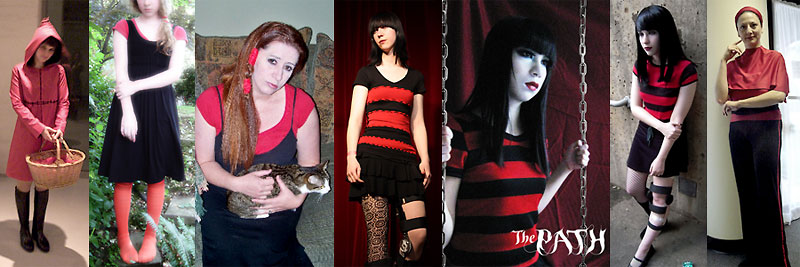
And of course, the iconic design of the Red Girls is hard to resist for any cosplayer worth their salt.
Translations
Some fans even contributed to the software itself, by offering to translate the text in the game for free. Since a lot of this text is quite poetic and cannot be translated literally, we did screen these people for having the required skill and talent. Thanks to their hard work, The Path can now be played in Danish, French, German, Hungarian, Italian, Portuguese, Romanian and Spanish next to the original English and Dutch and the publisher-localized Polish, Russian and Japanese. We’ve also been contacted by volunteers to translate The Path into Arabic, Czech, Farsi, Korean, Lithuanian and Swedish. So this story will continue.
Sales
Price
The Path is being sold at 10 US Dollars. This is a very low price for a game of its size. It was difficult to decide on a price. A year ago, when The Path was launched, the standard price for an indie game was still 20 or 25 Dollars. So throughout development, this was the price point that we had in the back of our heads. But after making a deal with “gamers platforms” Steam and Direct2Drive to launch The Path simultaneously with us, we started thinking.
We realized that The Path was a very different game. We were not anticipating the enthusiastic response from the games press at all. We actually thought The Path would be largely ignored by the press or receive a luke-warm reception. But we really wanted people to play it. So in order to reduce the risk of purchasing a game that you can’t find a decent review for, we decided to make the price as low as possible.
We’re still not certain of this was the right decision. The Path received a lot more publicity than we had expected. But would the reviews have been equally favorable if the price would had been “normal”? And would an increase in price have compensated for the inevitable decrease in copies sold at a higher price? These are questions we have no answer to.
Long tail

The Path sales graph over time shows a typical “long tail”: a steep spike at launch and a long period of mediocre sales numbers. Except for the “rude interruption” of the Indie Bundle sale on Steam (the spike of which is a lot taller than is visible on the graph). The first month and a half of sales (March and April) were good for a quarter of the entire year. When Valve launched the Indie Bundle discount sales, we sold even more than in the first month. Another, much smaller spike was caused by an interview on US radio station NPR.
Per region
Almost 50,000 copies of The Path have been sold to this day. Most of these (90%) via digital download through the internet. The Path has been our first product to be sold through retail as well. Topware published a localized version in Poland and 1C in the Russian speaking countries.
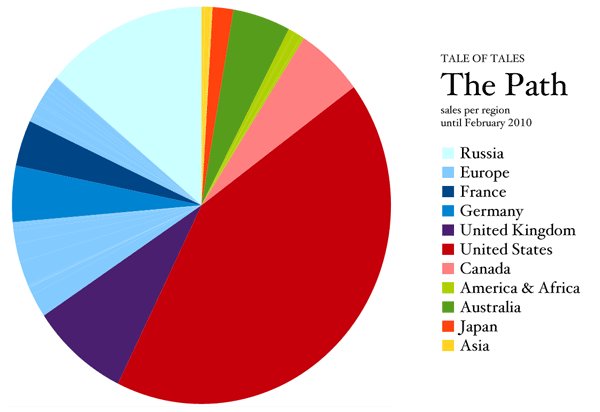
Almost half of the people who bought the Path live in North America, predominantly in the USA, though Canada did very well too. A good quarter of sales were made in Europe, mostly in the UK, Germany and France. About 10% of our sales were made in Russia and Russian speaking countries. Almost all of these through retail.
More than half of our sales happened in English speaking countries. The fact that our website and most of our marketing is in English may be one reason for this. The fact that most of our sales were made through channels owned by US-based companies another.
Per channel
We were lucky enough to sell The Path through Steam. Quite a bit more than half of our sales happened through Valve’s distribution platform. More than half of those sales come from discount bundles that were sold over a single weekend (these bundles contained several other indie games as well). But even if we remove the bundle sales from the equation, Steam sales still still account for almost half.
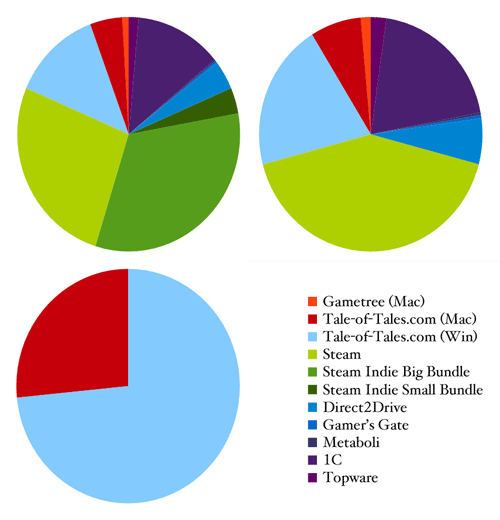
Because of the success of The Graveyard on Mac OSX, we were very eager to release The Path on Mac. Thanks to the help of Transgaming, we were able to release a Mac version in May 2009. Mac sales have not been as good as expected. Part of the reason for this is probably that the Mac version did not benefit from the excitement surrounding the launch in March 2009. Another reason is undoubtedly that our major distributors only carried the PC version of The Path. Still, if we extract the numbers of on an unbiased channel like our website, Mac sales only account for little over a quarter of sales. Even if we only count sales since the Mac launch, the PC version still sold almost twice as well as the Mac version.
There is no woodsman to save the women
Conclusion
Producing and releasing The Path has taught us that the amount of effort (and time and money) we put into a creation directly affects its public appeal. The Path has been our biggest production to date. And it has both received the highest praise and found the largest audience of any of our projects. Yet while it is nice to know that our hard work has been rewarded, the commercial success was too moderate to really justify a repeat of this same formula. Even if arts funding allows us to minimize commercial concerns, we feel that there is more opportunity out there, in terms of finding an audience.
We have learned that designing purely for non-gamers is relatively futile because the limited marketing means of an independent developer do not suffice to reach this audience. On the other hand we have also learned that at least part of the gamer audience is very open to the experiences we create, even if they cannot strictly be categorized as games. Taking care of the interaction design and the story-telling may be enough to appeal to this audience with a whole new range of themes and emotions.
Perhaps the PC/Mac market is too small for mid-sized indie games like The Path. We’re still hoping somebody can help us port the game to a console. And we are certainly considering console development more seriously for future projects, now that we know that there is a sizable enough audience for our work.
The Path shows that it is possible to talk about intimately personal things through the medium of videogames. Not just things that are personal to the authors, but also to each individual player. Through non-linearity, interactivity and procedural generation, we have created a piece that is really about the player. Not in a rigid, engineering kind of way, but in a playful, evocative way. We don’t know what everything in The Path means either. It doesn’t matter. Not anymore. Creating The Path was as much an intuitive experience as playing it can be.
We know the intensity of these emotions. We know how disruptive they can be. That next to them, nothing seems real. And this frightens us. Because we cannot live like that. The intensity is unbearable. The truth of pain slits the night of life with blinding light. We seek shelter in the lie, in the mask, in the story, and in the game.
We are not ashamed.
It is the only path through the forest.
Let’s go.
Article written by Michaël Samyn and Auriea Harvey in March 2010.
12 thoughts on “The Path post mortem”
Comments are closed.